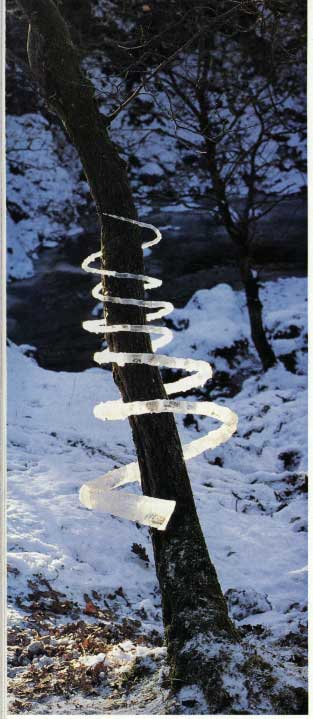Aufgehen
I've become obsessed with Andy Goldsworthy. His art expresses, in a perfectly aesthetic manner, the relationship between time and earth, delving into to the opacity of the inorganic and revealing it as the vital force that it is. Of course, many have indicated the living essence of the natural world, but usually this is part and parcel of an ontology that hypothesizes a universal organization to nature. The inorganic being is said to be part of a larger, living whole, organized for certain ends and it is precisely this participation in the living whole that gives them life. The lives of things are taken to be derivative. The meaning of their existence, then, comes from the goal toward which nature is said to strive.

Goldsworthy, on the other hand, does not seek the principle of the inorganic being's vitality outside of it: each being radiates lines of force, entering into asymmetrical relationships and lop-sided processes through which the "landscape" emerges as it appears. Each element of the work influences the others such that the meaning of the work comes neither from the whole, nor from the collective discrete meanings of the individual elements. Rather, Goldsworthy sets the elements into relation in order to express something that is their collective meaning, a meaning that is only discovered in their collective being. There is no pre-given sense that he seeks to impose upon the earth through his works;his work is always already there in the relations between the elements, in their play with one another.

The core of his work is time. Many artists strive to make their art temporal, using time to create an effect, employing time so as to make a conceptual point. The power of Goldsworthy's work lies not in his harnessing of time, but in the fact that he allows time to participate in the work. This is not to say that he makes time into an object to be seen within the work. Rather, what the work expresses is the finitude of natural existence, the emphemeral interdependencies and transient involvements and affinities between beings. The stone and the river, as stone and river and not as constituents of a larger organization, express something of the forces that constitutes both as they are, the same energy that flows through all. Without the river, the stone would be rough, and without the stone, th river's flow is altered.

What is so wonderful about Goldsworthy is that he is able to allow nature to express itself in his work rather than trying to make it speak. His art transcends stereotypical dichotomizations of nature and culture without reducing one to the other. There is no human within nature: the human is natural. At the same time, however, because humans are natural beings, the cultural order cannot be criticized as a falling away from nature or as antithetical to nature. The myth of pristine wilderness must be dispelled. Goldsworthy's work captures this equally in water flowing with color, fallen leaves, melting ice, and cairns of stone.

Goldsworthy, on the other hand, does not seek the principle of the inorganic being's vitality outside of it: each being radiates lines of force, entering into asymmetrical relationships and lop-sided processes through which the "landscape" emerges as it appears. Each element of the work influences the others such that the meaning of the work comes neither from the whole, nor from the collective discrete meanings of the individual elements. Rather, Goldsworthy sets the elements into relation in order to express something that is their collective meaning, a meaning that is only discovered in their collective being. There is no pre-given sense that he seeks to impose upon the earth through his works;his work is always already there in the relations between the elements, in their play with one another.

The core of his work is time. Many artists strive to make their art temporal, using time to create an effect, employing time so as to make a conceptual point. The power of Goldsworthy's work lies not in his harnessing of time, but in the fact that he allows time to participate in the work. This is not to say that he makes time into an object to be seen within the work. Rather, what the work expresses is the finitude of natural existence, the emphemeral interdependencies and transient involvements and affinities between beings. The stone and the river, as stone and river and not as constituents of a larger organization, express something of the forces that constitutes both as they are, the same energy that flows through all. Without the river, the stone would be rough, and without the stone, th river's flow is altered.

What is so wonderful about Goldsworthy is that he is able to allow nature to express itself in his work rather than trying to make it speak. His art transcends stereotypical dichotomizations of nature and culture without reducing one to the other. There is no human within nature: the human is natural. At the same time, however, because humans are natural beings, the cultural order cannot be criticized as a falling away from nature or as antithetical to nature. The myth of pristine wilderness must be dispelled. Goldsworthy's work captures this equally in water flowing with color, fallen leaves, melting ice, and cairns of stone.